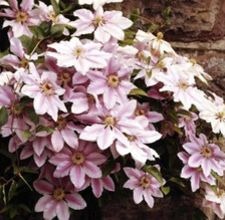Clematis is a woody, deciduous vine. It is a member of the buttercup family and the genus includes many different varieties, each with its own display of very showy flowers. Under the right conditions, the plant can live for upwards of 25 years. If you find after a few years that the site you chose for your clematis isn’t ideal and you need to transplant the vine, the best time to do so is in the early fall, late winter or very early spring. Transplanting at these times will allow the vine to establish its root system before the next growing season.
Prepare the New Site
-
The Ohio State University Extension recommends that growers prepare the new site before uprooting the vine from its old site. The new site should have soil with a neutral pH — or a number very close to neutral — and should be in full sun. Clematis vines with bright red or blue flowers, however, are susceptible to fading in full sun, so take that into consideration. Some dappled afternoon shade could be beneficial in this case. If the soil is compacted, incorporate compost or well-rotted manure into the planting hole equaling up to one-third the volume of the backfill. The hole should be 24 inches deep and 3 feet wide, according to the Ohio State University Extension. Water the hole and let it drain completely if the soil is very dry.
Dig Up the Vine
-
Preserve as much of the original root ball as possible, as clematis roots don’t like to be disturbed. Water the area around the root ball, soaking it as much as possible before digging it up to keep the root ball from crumbling.
Transplant the Vine
-
Place the root ball in the new location and replace the backfill. Water in the backfill as you replace it to remove air pockets. You want the root crown to sit 1 to 2 inches below the surface of the soil. This protects the root crown and allows it to generate new vine shoots in the event the existing vines are damaged. Mulch the area around the root ball with 2 inches of pine bark mulch, pine needles, grass clippings or decomposed leaves. This will keep the roots protected throughout the winter. Lay more mulch when the weather warms to keep the soil cool and conserve moisture.
Support
-
Mature clematis vines can be quite heavy. Unless you plan to allow the vine to roam over the ground, you’ll have to provide a strong support system. A trellis or a section of lattice leaned up against a fence will serve just fine.


Deprecated: strpos(): Passing null to parameter #1 ($haystack) of type string is deprecated in /home/agriviek8Qv/agriviet.net/public_html/wp-includes/comment-template.php on line 2522